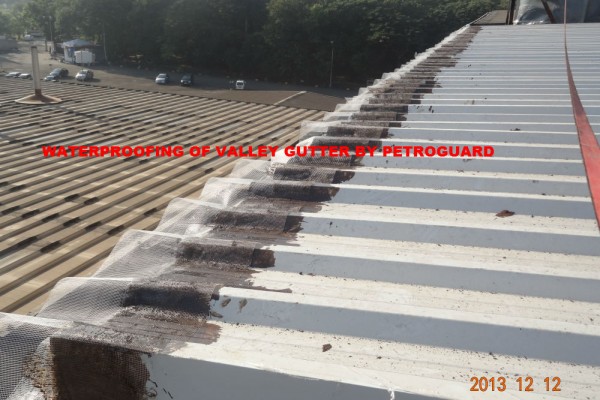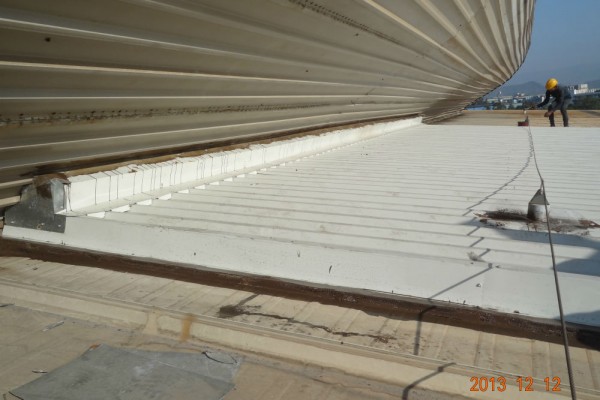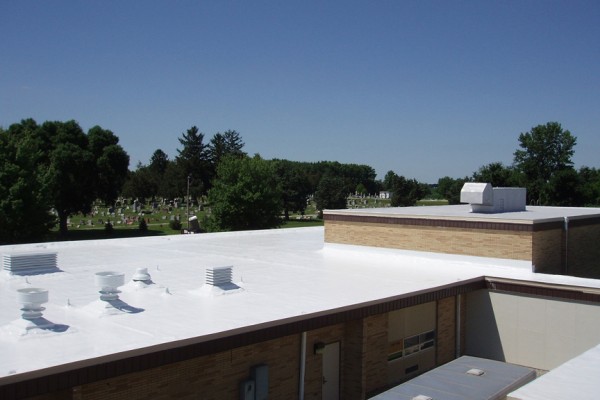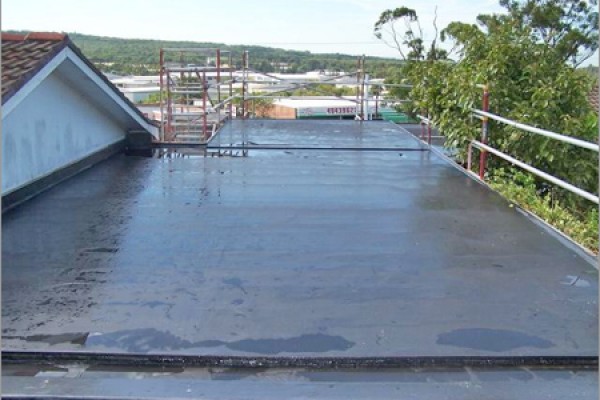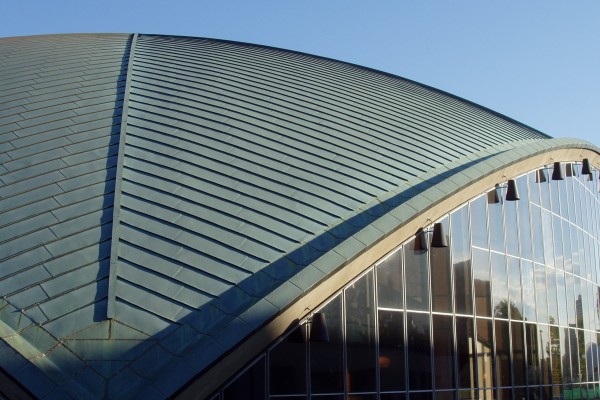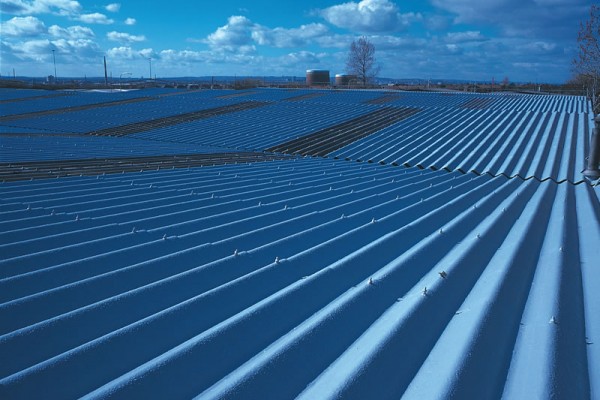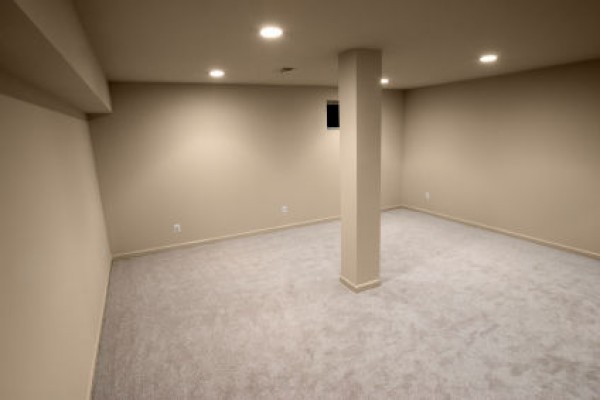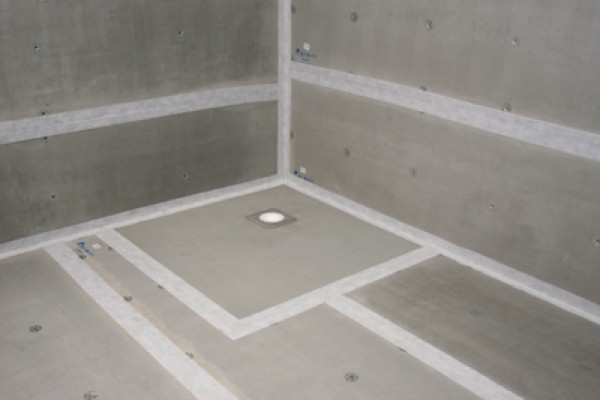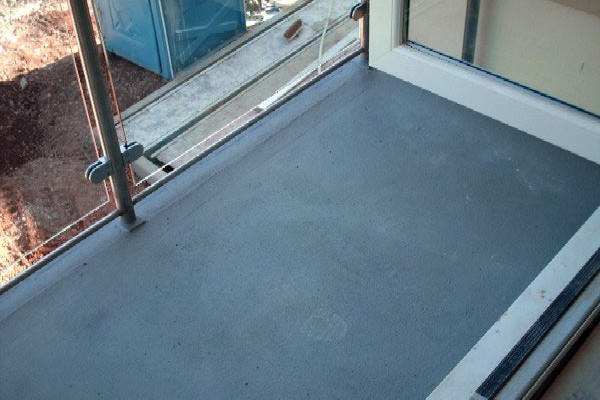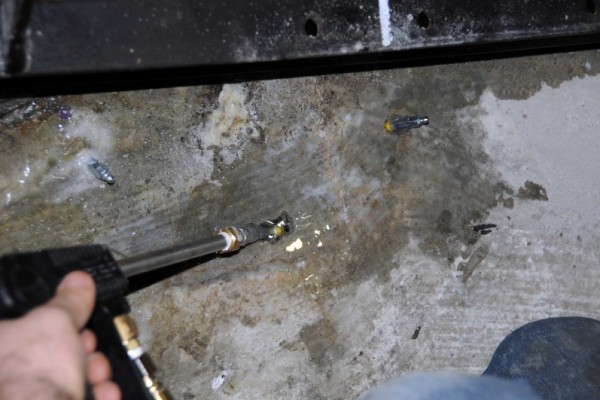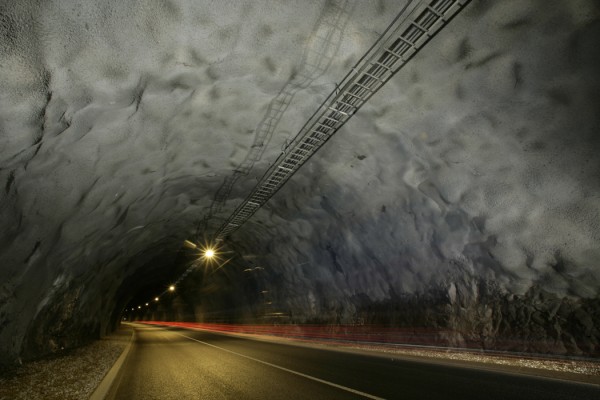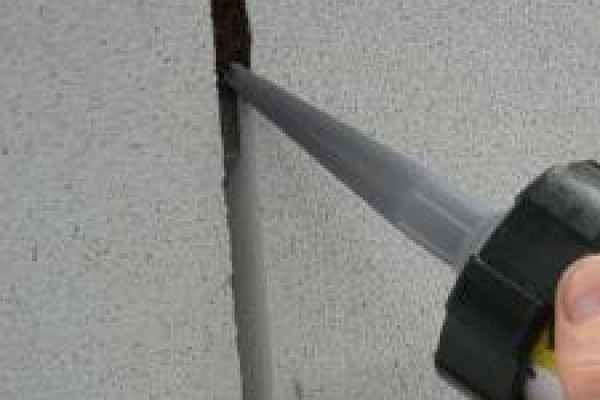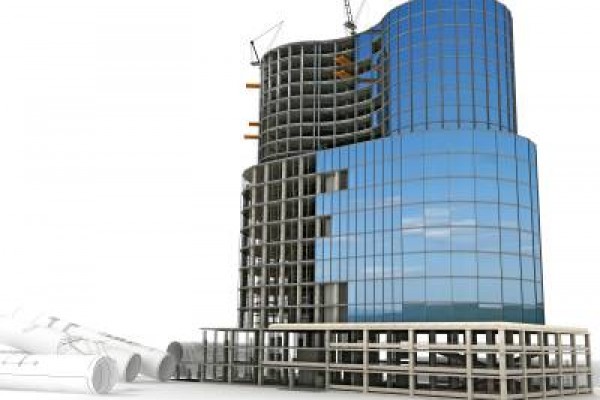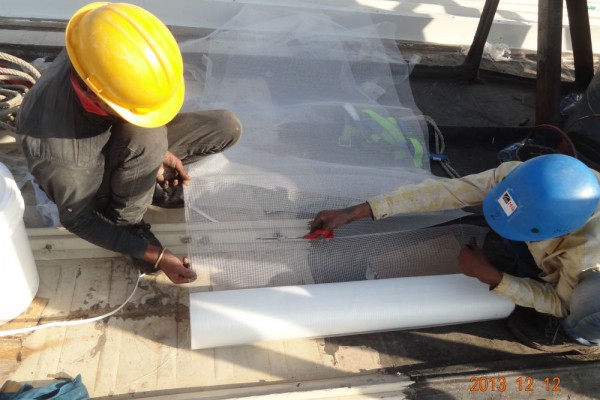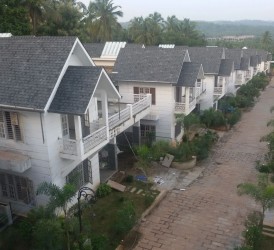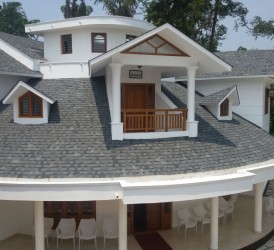Our Innovative and Highly Effective Waterproofing Solutions are made for both Concrete Buildings, Terraces, Balconies, Side Walls, Basements, Injection Pump for Cavities and for Metal Roofing Systems, such as Galvalume Roofing Sheets, PUF Panels, Double Skin Sandwich Roofing Systems, etc. and can prevent leakages for a very long time. The difference of Petroguard Waterproofing Solutions is that of its flexibility even after several years of application.
Due to a very unique chemical compound in our products, the finished surface does not crack or peel off due to the weather conditions. We also use a heat reflecting substance so as not to radiate heat through the coating, which will help the surface last for long.
We have a professional team of skilled and well experienced personnel to undertake the turn-key projects for the supply and application of Petroguard Waterproofing Solutions for Industrial & Commercial Establishments, Airports, Hotels, Hospitals and Residential Complexes, etc. As of now, we have executed several projects for major clients like Adlabs Imagica, Mumbai International Airport, Owens Corning (India) Limited, Eversendai Engineering Limited, etc.
We do commit and deliver an excellent service to all our clients, who are very precious to us. Our promptness in supplying quality materials and executing the work are very much appreciated among our clients.
The Safety of our workers is of utmost importance to us and therefore, we adhere to very strict safety measures at the work places. Under no circumstances, the safety of our workers will be compromised. We utilize the best quality safety equipment/products like – Vented Helmet, Safety shoes, Vertical Fall Arrester Systems with Polyamide Rope, Full Body Double Harness Safety Belt with Shock Absorber, Edge Retractable Fall Arrester System with Shock Absorber, Horizontal Anchoring Lifeline and Metal Pipe Scaffolding. Besides, all our workers are covered under Workmen Compensation Policy.
| Advance waterproofing systems for preventing water leakages in buildings Water seepage occurs mainly from external wall, window, roof, or from ceiling which may cause water staining, peeling off of paint or wall paper, water dripping, growth of fungus, defective concrete, plaster, debonding of tiles and rust staining. This could be due to a variety of reasons. They are common defects in causing nuisances to occupiers across floors. It is sometimes very difficult to identify the source or cause of water seepage for which an extensive investigation may be necessary to track down the source of leakage. Many homeowners often ask for a list of warning signs of water leakage and damage. Such queries come more often in the cities that endure excessive rainfall, prolonged rainy season such as Mumbai. It is extremely important in such places to have a list as a guide for self-inspection in the hope that they might have an early detection of problems and consequently their timely redressal. A tentative check list is given below for a ready reference along with remedial measures and solutions. Leakages from roofs such as flat roofs, podium roofs etc. The main reasons for water leakages are water stagnation, inadequate slope for drainage of rain water and damage or deterioration of waterproofing system. Leakage occurs through pores and connected capillaries in the concrete structures there by corroding the reinforcement. Sometimes defective enclosure for water tanks, cracks of parapet walls affects the waterproofing systems. Inadequate protection of roof slab or improper installation of waterproofing system may also lead to leakages. Waterproofing of Terraces and Balconies People are still following the old traditional methods of brick bat coba or china mosaic for waterproofing of terraces and balconies. But if some cracks develop through these surfaces due to some reasons then instead of waterproofing they become source of water storage as bricks are porous in nature. This can be avoided by using latest waterproofing materials such as liquid-applied acrylic co-polymer based coating or a membrane. These are more elastic and suitable for anticipated movements in the roof structure. Because of their higher crack bridging ability they hide the hair line cracks which develop on the roof surface. Liquid applied coating can also be exposed to weather and sunlight but membranes require protection such as cement sand screeding. Life span of such materials is more than 8-10 years. But the most important is to provide a suitable gradient of 1:80 to 1:100 to surface to avoid any ponding of water. The other points to be noted are required thickness of the waterproofing materials, overlapping of the material at junctions, upturns of the material at parapets and walls, protruding of pipes and ducts, and overall the surface preparation and right method of application of such materials. These materials can be used over existing brick bat coba or china mosaic surface without dismantling the old water proofing system. Comparing to dead load of brick bat coba these polymeric waterproofing material hardly add any weight to the surface. Damp patches on walls Water penetration take place through external wall defects such as hairline cracks, joints, honeycombs, spalling, weak points, holes, punctures and leftovers of debris. The hairline cracks begin to grow further, allowing seepage of water. The movement of external wall components leads to settlement cracks on the wall. Also, water penetration takes place through defective external wall finishes such as loosened mosaic tiles, cracked ceramic tiles & paint surface, poor cladding or curtain walls constructions. Another cause may be due to water leakage through walls between units of pre-fabricated elements. Waterproofing of External walls In most of the buildings in Mumbai the external walls are repaired for shrinkage cracks which may be mistaken as some decorative treatments by any newcomer. The external walls can be protected by an acrylic based coating which are highly elastomeric and prevent ingress of moisture through hairline cracks. They can be tinted for any desired colour for a highly decorative coating. They have very low dirt pick characteristics making the coated surfaces looking glossy. They have a long service life of 6-8 years. They are excellent coating for application on external cementitious surfaces in a highly humid and marine climate like Mumbai. They are not only durable but make the building durable by acting as a strong barrier between the substrate and the extreme environment. The old and heritage buildings of stone and brick masonry should be protected with a water repellent such as Silliconate based coating. It is a transparent coating which does not change the original colour of the building. It is nonstaining and prevents the ingress of moisture into the masonry surfaces. It also prevents the efflorescence and growth of fungus on external surfaces. It is very much suitable for protection of such masonry buildings. Treatment of dampness of internal walls All the internal dampness of walls, ceilings, bathroom, toilet, and kitchen can be repaired with an epoxy based damp proof coating. For internal areas having moisture such coating can be used as putty with OPC white cement. But this cannot be used in areas having excessive dampness; a crystalline coating will be suitable for such areas. Growth of mold, mildew and fungus inside the building Due to ingress of moisture the growth of mold, mildew and fungus take place inside the building. All these become visible after colonization of spores and showing discoloration of paints and coatings and creating unhygienic atmosphere inside the buildings. This can be prevented or repaired with application of a polyurethane based anti-microbial coating. Leakages from internal wet areas Leakage from bathrooms or kitchens usually caused by seepage from fitments, bathtubs, shower trays, buried pipes or drains due to improper construction of joints and improper installation of sealants. The inadequate slope of such floors may lead to water stagnation for some times due to which water may penetrate through the tile joints. Waterproof cement rendering underneath floor tiles for the floor not installed properly and improper installation of sockets or conduits are some of other causes of bathroom leakages. Waterproofing of internal wet areas Before doing the waterproofing layer of a floor, all the sanitary fitments and finishes should be treated with appropriate waterproofing systems. Waterproof cement sand screeding or other similar materials is commonly used for this purpose. The screeding should be applied to have sufficient upturns at the base of the walls, and have an adequate gradient of 1: 40 to 1:60 at the floor for draining out water immediately and to prevent water ponding. Sanitary fitments are to be installed on top of the waterproofing layer without penetrating it. The floor surface under the bathtub or shower tray should be given proper slope to avoid trapping water at their bases. Tiles should be fully bedded with tile adhesives. After applying the floor finishes, the joints between tiles should be grouted properly with tile grouts. Junctions of wall finishes and bathtub or shower trays should be sealed with suitable silicon sealant. Gaps between marble tiles should be fixed with flexible waterproofing joint sealant to prevent long term minor movement giving rise to cracks for water penetration. Leakages from metal pipe surfaces Seepage through defective joints or pipes caused by poor installation or differential movements and settlements are the main causes of water leakages from metal pipes. Corrosion of metal pipes at junctions with floors or walls, invasion of water into conduits, blockage in pipes leading to excessive pressure built up or sometimes attack by rodents or roots of plants causing damage of metal pipes and leakages occurring at these locations. In case of exposed supply pipes or drains there may be inadequacy in design of drains such as insufficient diameter, bends being too sharp, etc. Also blockage of drains at the junction of bends or traps, open joints such as hoppers of down pipes may lead to leakages of water. Leakage through joints The leakage through the windows may be due to forming of gaps between window frame and masonry, between the lintel beam and masonry and through the alumimium frame and window sill. The leakage occurs through other joints such as expansion and contraction joints, joints between columns and beam with masonry and all sanitary fittings. Sealing of leakages at windows Instead of sealing the gaps between frame and masonry with putties, the same can be sealed with an acrylic sealant which acts as a gap filler. The minor movement at these joints cannot be accommodated by a normal putty for which defect arises after some period of time which can be avoided by sealing with an acrylic sealant. Sillicone sealants can also be used for sealing those gaps. Treatment at Joints People often use cement mortar to seal the gap between masonry and RCC beam and columns of the structures. Chicken mesh also widely being for this purpose. Because of different types of materials they expand and contract differently for which cracks develop afterwards. This can be treated with a silicone sealant or applying a polymer modified mortar which can take care of expansion and contraction. All sanitary joints can be sealed with sillicone sealants. The other expansion and contraction joints of structural members of large buildings can be treated with polysulphide sealants to prevent leakages through these joints. Musty smell coming from the basement may be subtle but grows stronger This may be due to inadequate or damage of tank waterproofing systems (due to movements or punctures) and also may be due to deterioration of water stops at construction and movement joints. Basement waterproofing Basement waterproofing requires a thorough study of site conditions including types of soil, ground water table and pollutants present in the soil and also external environment related to humidity, moisture temperature and required internal environment in terms of dryness. The various systems of basement waterproofing includes tanked protection where a liquid applied coating or membrane can be applied on all internal surfaces, integral waterproofing system where structure has to be designed like a water retaining structure or a combination of those two for important structures. Malls and public buildings should have additional provision of drainage system equipped with a pumping system. In case of basements all joints are very much critical which should be provided with water bar at all horizontal and vertical joints of floors and walls. For existing basement structures facing the problem of moisture ingress, can be rectified with a crystalline coating. For basements having water seepages or leakages can be rectified by a polyurethane injection. Treatment of rising dampness Rising dampness occurs at the plinth level and above due to inadequate damp proof protection at plinth level. Siliconate injection grout can be used to prevent such rising dampness. Peeling of paint from wood surfaces If there are wood surfaces, paint begins to peel off from the window frames, doors and other surfaces. This may happen due to improper fillings around frames and deformation of frame and sashes, defective gasket, sealant or putty for window glass setting or frames. The other factor which may lead to wood surface due to moisture ingress may be due to air conditioning box or platform tilting inwards or insufficient sealant around air conditioning units. The signs of distress may be observed from the facts that appearance of powdery substances appearing on the furniture and odour coming out from furniture and draperies. An acrylic sealant or a silicon sealant can be used to sealing at those gaps thereby avoiding those problems. Many of the above signs become visible only after the leakages and damages reach a critical stage. It is best to inspect early and often. If any of these signs are visible, call in a professional water proofing agency. Remember that the water damage creates problems not only to your house; it additionally causes various health issues. If you are serious about your property, you should attend to any leakages from plumbing and drainage line immediately to prevent damages to wall and structure. Terrace should be cleaned every month. All bath, water closet and kitchen nahani traps are vulnerable areas that demand careful and frequent check. All cracks on the external walls should be inspected and repaired as soon as detected. |
Waterproofing of Roofs - A Step by Step Approach
Waterproofing of existing roofs is a critical challenge and the methodology varies from case to case basis. It is first important that you understand why the leakages happen from the roofs:
- Improper slope of the roof surface leads to water stagnation
- Defective enclosure for over head water tanks may lead to continuous accumulation of water on the roof surface
- Cracks on base slabs and parapet walls make the pathways for the water to move inside the building elements.
- Vegetation growth on the terraces allows the moisture to percolate through their roots embedded inside the slabs.
- Inadequate protection of roof slab or improper installation of waterproofing system may also lead to leakages. As the reasons are varied, a proper systematic approach can lead to an effective result
1. Visual Observation
- Slope of the roof surface and position of service pipelines are adequate to drain out the water
- Visibility of cracks on the surface absorbing the water inside
2. Expert Diagnosis
- Condition of the roof slab
- Depth of cracks on the surface
- Moisture content
3. Structural audit
It is recommended only in case of heavy and all over leakages through various building sections
4. Specifications and recommendations
A proper waterproofing methodology is to be sketched after all the data are analyzed and then accordingly the right products / systems have to be specified.
4.1. Conventional vs. Advanced waterproofing techniques
Though the roof waterproofing done by conventional waterproofing systems like Bitumen, Brickbat coba, mud phuska proved to be successful against times, but they have their inherent problems like short life and long installation procedures delaying the time-bound projects. Climatic changes and weathering effects are one of the major issues for the non acceptability of these techniques. And, when we talk about specifically about very popular brickbat coba (BBC) as roof waterproofing, the system technically fails to provide any waterproofing solution. The porous bricks and in-filling mortars used absorb a lot amount of water inside the system and ultimately turns out to be a water pool rather that a watertight barrier. Another major issue with BBC is its dead weight on the slab structure.
The advancements in waterproofing materials and technologies have revolutionized the modern construction industry, not only with their ease of applications but also longer durability and less maintenance aspects.
A. Liquid applied coating / membrane systems
- Polymer modified cementitious coatings
- Hot and cold applied bitumen coatings
- Acrylic copolymer based liquid applied membrane systems
- Polyurethane based liquid membranes
B. Preformed sheet membranes / barrier systems
- Polymer (APP / SBS) modified bitumen sheet membranes
- EPDM rubber membrane
- TPO Membrane
4.2. Selection of Materials and Techniques
The selection of the right material depends on the type of roofs, climatic conditions and suitability of application. Normally, coatings or liquid applied membranes are used for small terraces while sheet membranes are the best options for large terraces. Moreover, one must also ensure to check the thermal coefficient and elastomeric property of the systems before application on the base slab. A mismatch in thermal coefficient would lead to the failure of the system while undergoing thermal expansion-contraction cycle.
The expansion or isolation joints in the base slab, in case of large terraces should be protected with elastomeric polysulphide based joint sealants.
Penetration of water normally takes place through hairline cracks, joints, honeycombs, holes and punctures. Specialized polymeric crack filling material or polymer mortars should be used to fill up those areas and the external faces to be covered with weather resistant protective coatings rather than decorative finish paints.
Removal of unwanted vegetation along the building facades and subsequent filling of gaps with moisture insensitive polymeric mortars would be the right choice.
5. Application of waterproofing materials and systems
Application of waterproofing materials is unique as per materials and manufacturers' specifications. When considering the millions of square feet of waterproofing systems installed and miles of sealant involved in building envelopes, it can be estimated that only 1 percent of envelope failure and resulting leakage is actually attributable to materials or systems actually failing. The reasons typically involved in failures include human installation errors, the wrong system being specified for inplace service requirements (e.g., thermal movement encountered exceeds the material's capability), the wrong or no primer being used, inadequate preparatory work, incompatible materials being transitioned together, and insufficient - or in certain cases such as sealants, too much - material being applied.
Fundamentally, waterproofing failures are attributable mostly for improper preparation of base surface before installing the system - hence it requires an utmost important to keep a proper watch while installation of a system is to be undergone. For example, cleaning of loose particles, oil etc. followed by checking of moisture content before application of a sheet membrane or preparing a surface saturated dry (SSD) substrate before application of a polymer modified cementitious coating are the prime requirements to get the desired results.
6. Protection and Maintenance Requirements
As any material requires maintenance, whether be it a human body or a car of your choice, roofing treatments should also be kept under a proper maintenance schedule. For example, any unspecified movement without adequate protection over a coating will lead to the rupture of the film; the bitumen sheet membrane should be protected from direct sunlight by providing either a protecting screed or a protective aluminium coating over it.
Over and above, maintenance plays a vital role to save your own property deteriorated from nuisance factors. Cleaning of terraces, regular checking of vulnerable areas like rain water outlets, plumbing lines etc. help the structures to last for a longer life.
The awareness of waterproofing and its implications is a must consideration for today's engineers engaged in building of durable structures. Otherwise, we will continue to spend money only on repair and maintenance rather than creating the best infrastructures.





